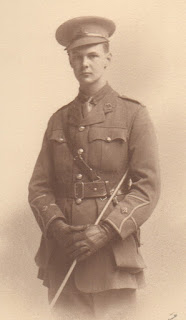Billets at Concamarise.
The day was much colder with the overnight frost persisiting
for much of the day. Starting at 7.14am the Battalion marched a further
fourteen miles via Sanguinetto, Cerea and Legnago to Minerbe. At Lenago where
they crossed the River Adige the Battalion received another memorable welcome,
but also encountered defeated Italian troops, as recalled by Capt. William Norman Town (see 19th November), “we marched through the town of Legnago amid
scenes like those at Mantua. As we
emerged from the town and crossed the bridge over the Adige,
chrysanthemums in rifle barrels and Sam Brownes till we looked like Jacks in
the Green, we met groups of the broken Italian Army moving back, without
rifles, without apparently much discipline.
One could not help wondering what they thought about things. One thing which greatly impressed the Italian
populace was the clean and smart turn-out of the 23rd Division. “These troops must have come straight from England,” they said, “they cannot have come from
the fighting in France.”
Pte. Walter Dey (see 29th October) was
admitted via 69th Field Ambulance and 38th Casualty
Clearing Station to 11th General Hospital in Genoa; he was suffering
from ICT (inflammation of the connective tissue) in his neck and wrist.
Pte. Francis John
Bottomley (see 31st
October), serving with 2/4th
DWR, was killed in action as the Battalion attacked near the village of Anneux,
west of Cambrai; he was one of around 120 other ranks killed or wounded during
the attack. It would appear that his body was initially identified and buried
but the site of his grave was lost in subsequent fighting and he is now
commemorated on the Cambrai Memorial, Louverval.
Pte. Harold Walker
Bray (see 10th September),
serving with
2/6thDWR, was wounded in action, suffering injuries to his right eye
and left hand. He appears to have remained in France, although the details of
his treatment are unknown.
Pte. James Moran
(see 21st September) was
formally transferred to the 4th Labour Company, Labour Corps serving
in France.
Capt. Bob Perks
DSO (see 6th November),
serving with 3DWR at North Shields, wrote to his father, “I am busy in a small,
petty and very annoying way. I have very
few men still but in all stages of training.
I got 20 poor raw recruits from Halifax yesterday but to-day they have
pinched 30 from me who volunteered for India little guessing I expect at their
probable future in Mesopotamia. However I seem to be becoming greatly in favour
with the C.O. in this process which means he will try to keep me as long as
possible. That is all right until after Christmas but I cannot really imagine
myself indispensable after that. On
Friday I am to do a show for the Inspector General of Infantry with my Company
– digging as the 10th do it”.
(I am greatly indebted
to Janet Hudson for her kind permission to allow me to quote from Bob Perks’
correspondence).
 |
Capt. Bob Perks DSO
Image by kind permission of Janet Hudson
|
Pte. Arthur Wideman
(see 5th October) was
posted from Northern Command Depot at Ripon to 3DWR at North Shields.
Lt. George Stuart
Hulburd (see 29th October),
who had been in England since having been wounded on 20th September,
wrote to War Office from no.19 Ward, Cambridge Hospital, Aldershot, with his
application for a wound gratuity for the wounds he had suffered at Inverness
Copse on 20th Sept. (The
letter was clearly written by someone else, and Hulburd added his signature in
a very shaky hand).
 |
Lt. George Stuart Hulburd
Image by kind permission of Paddy Ireland
|
The former Battalion Chaplain, Rev. Wilfred Leveson Henderson MC (see
25th October), who had been severely wounded in the attack on
the Messines Ridge on 7th June, appeared before an Army Medical
Board at Larkhill War Hospital, Glasgow. The Board recommended that he continue
his treatment at the hospital and declared that his case would be re-examined
in two months time. Five days later Henderson would write to the War Office
requesting information about his eligibility for a wound gratuity.
Mary Ann Green wrote to the War Office in response to their
recent request for a copy of her marriage certificate and children’s birth
certificates, as the wife of Pte. Thomas
Bates (see 11th November);
“I am writing these few lines in answer to your letter. I am sorry to tell you
that I am not his wife but I have lived with him for years and I have tried all
my hardest to get him home so that he could marry me and I got the banns in now
if he was to come home as this is three times he has been away in 17 months and
never had a days leave yet. Sir, I have never had nothing wrong with my pay
before till now. Sir will you let me have the certificate back as soon as you
can and three children are his Pte. T. Bates and 2 is mine. He is a widower and
I am a widow and I would be pleased if you will kindly send me my draft book
through”.
L.Cpl. Willie Marsden (see 6th March),
who had suffered very severe wounds in the trench raid in November 1916, was formally
discharged from the Army as being no longer physically fit for service on
account of his wounds. He was awarded the Silver War Badge and would be awarded
an Army pension of £1 7s. 6d. per week for four weeks, reducing thereafter to
16s. 6d.
A payment of £2 3s. 4d. was authorised, being the amount due
in pay and allowances to the late Pte. Joseph
Clayton (see 21st March),
who had died whilst serving with 83rd Training Reserve Battalion at
Gateshead; the payment would go to his father, William.
No comments:
Post a Comment